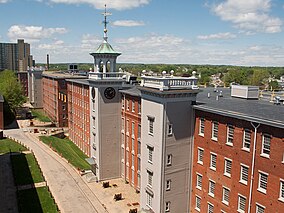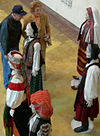Lowell National Historical Park: Difference between revisions
Reverted to revision 314178443 by Seelouise58; ret apparant good-faith blanking. (TW) |
What is the purpose of "The Public Historian" set of links and references at the footer of this page? It doesn't articulate any specific relevance to Lowell National Historical Park. Deleted. |
||
| Line 65: | Line 65: | ||
[[Category:Lowell, Massachusetts]] |
[[Category:Lowell, Massachusetts]] |
||
[[Category:National Park areas in Massachusetts]] |
[[Category:National Park areas in Massachusetts]] |
||
'''The Public Historian''' is the official publication of the [[National Council on Public History]]. It is a quarterly [[journal]] published by [[University of California Press]], in [[Berkeley, California]]. First published in 1978, ''The Public Historian'' publishes the results of scholarly research and case studies in such areas as: public policy and policy analysis; federal, state, and local history; historic preservation; oral history; museum and historical administration; documentation and information services, corporate biography; and public history education. The ISSN is 0272-3433. |
|||
==Links== |
|||
* ''National Council on Public History'' [http://www.ncph.org/ official website] |
|||
* ''The Public Historian'' [http://www.ucpressjournals.com/journal.asp?j=tph on University of California Press Journals website] |
|||
*[http://www.ulib.iupui.edu/special/gencoll/coll/mss021.html National Council on Public History Archives] |
|||
[[Category:Journals|Public Historian]] |
[[Category:Journals|Public Historian]] |
||
Revision as of 13:17, 21 September 2009
| Lowell National Historical Park | |
|---|---|
 The Boott Cotton Mill & Museum | |
| Lua error in Module:Location_map at line 526: Unable to find the specified location map definition: "Module:Location map/data/US_Locator_Blank.svg" does not exist. | |
| Location | Lowell, Massachusetts, USA |
| Nearest city | Lowell, Massachusetts |
| Area | 141 acres (0.57 km²) |
| Established | June 5, 1978 |
| Visitors | 574,410 (in 2008) |
| Governing body | National Park Service |






Lowell National Historical Park is a National Historical Park of the United States located in Lowell, Massachusetts. Established in 1978 a few years after Lowell Heritage State Park, it is operated by the National Park Service and comprises a group of different sites in and around the city of Lowell related to the era of textile manufacturing in the city during the Industrial Revolution.
History
- See the History of Lowell, Massachusetts article for a detailed history of the city
First settled by Europeans in the 17th century, East Chelmsford (later re-named Lowell in honor of the founders' deceased business partner) became an important manufacturing center along the Merrimack River in the early 1820s. It was seen as an attractive site for the construction of a planned industrial city, with the Middlesex Canal (completed in 1803) linking the Merrimack to the Charles River, which flows through Boston, and with the powerful 32' Pawtucket Falls. The already existent Pawtucket Canal, designed for transportation around the Pawtucket Falls on the Merrimack, became the feeder canal for a 5.6 mile long system of power canals based around the falls. Unlike many other mill towns, however, Lowell's manufacturing facitilities were built based on a planned community design. Specifically Lowell was planned as reaction to the mill communities in Great Britain, which were perceived as cramped and inhumane. Initially the factories of Lowell were built with ample green space and accompanying clean dormitories, in a style that anticipated such later architectural trends as the City Beautiful movement in the 1890s. Lowell attracted both immigrants from abroad and migrants from within New England and Quebec (including a large proportion of young women) who lived in the dormitories and worked in the mills.
The mill industry in Lowell went into a steep decline in the middle 20th century and by the 1960s, the city's manufacturing district was largely in ruins. Urban renewal plans called for the paving over of the canals. The idea of creating a historic district in Lowell was largely the idea of local teacher Patrick J. Mogan, who insisted that any revitalization of the city should be based on its industrial and ethnic heritage. Mogan believed that this was the soul of the city—and not incidentally, a key to its economic salvation. As a result, group of community organizations began cooperating on a comprehensive plan to renovate the historic heart of the city. In 1978, the United States Congress established Lowell National Historical Park and the Lowell Historic Preservation Commission. The legislation to create the park was sponsored by United States Senator and Lowell native Paul Tsongas. The restoration gathered momentum in the 1980s, including the renovation of the canals and former mill facilities into museums, as well as the construction of a waterfront walkway.
Description
The park includes a Visitor Center, as well as many restored and unrestored sites from the 19th century. The Visitor Center provides a free self-guided tour of the history of Lowell, including display exhibits such as the patent model of a loom by local inventor S. Thomas.
A footpath along the Merrimack Canal from the Visitor's Center is lined with plaques describing the importance of various existing and former sites along the canal. The Boott Mills along the Merrimack river, on the Eastern Canal, is the most fully restored manufacturing site in the district, and one of the oldest. The Boott Mill provides a walk-through museum with living recreations of the textile manufacturing process in the 19th century. The walking tour includes a detour to a memorial to local author Jack Kerouac, who described the mid-20th century declined state of Lowell in several of his books. A walkway along the river leads to several additional unrestored mill sites, providing views of restored and unrestored canal raceways once used by the mills. Additionally, the park includes the Patrick J Mogan Cultural Center, which focuses on the lives of Lowell's many generations of immigrants. Other exhibits include a working streetcar line, canal boat tours exploring some of the city's gatehouses and locks, and the River Transformed / Suffolk Mill Turbine Exhibit, which shows how water power, namely the Francis Turbine, was once used to run Lowell's textile factories.
See also
External links
- Lowell National Historical Park website
- Lowell National Historical Park 2009 Annual Report
- Heritage Preservation and Development White Paper: A 30 Year Assessment of Lowell National Historical Park
- Presentation of Lowell Stories White Paper: A 30 Year Assessment of Interpretation and Education at Lowell National Historical Park
- Building America's Industrial Revolution: The Boott Cotton Mills of Lowell, Massachusetts, a National Park Service Teaching with Historic Places (TwHP) lesson plan
- Economic history of the United States
- History of Massachusetts
- National Historical Parks of the United States
- National Register of Historic Places in Massachusetts
- Lowell, Massachusetts
- National Park areas in Massachusetts
- Journals
- Academic journals
- History journals
- Public history
- Protected areas established in 1978
- Industry museums in Massachusetts
- Textile museums in the United States
- Museums in Middlesex County, Massachusetts


